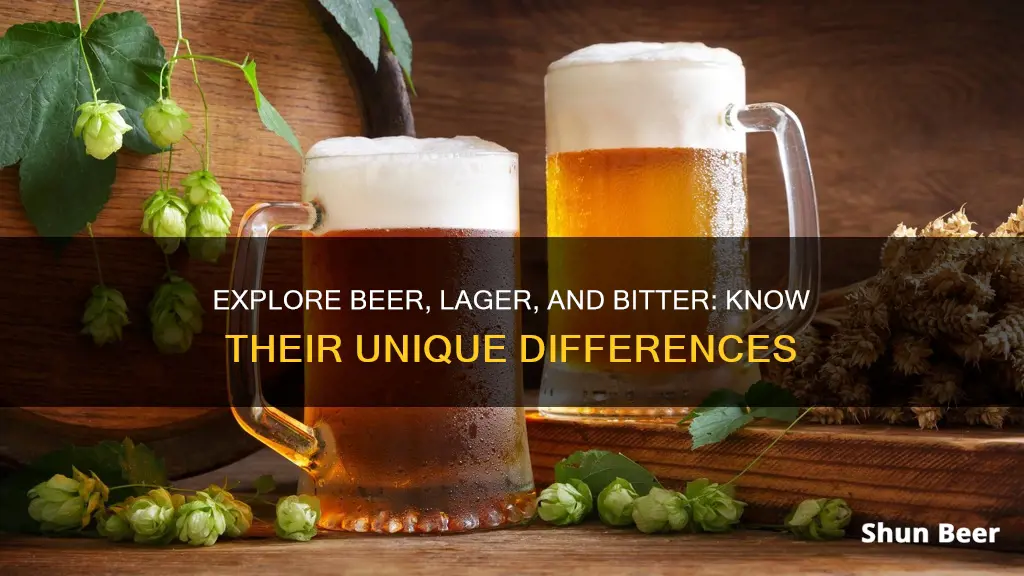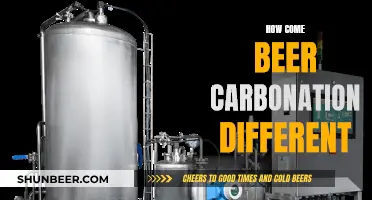
Beer is broadly classified into two types: lager and ale. The primary difference between the two is the type of yeast used in the brewing process. Ales are created through top fermentation, where yeast ferments at warmer temperatures and settles at the top of the beer. Lagers, on the other hand, are produced using bottom-fermenting yeast at colder temperatures, and the process is longer. Ales have a more full-bodied and fruitier flavour due to the production of more esters, while lagers tend to have simpler flavours and are lighter in colour.
Differences between Lager and Bitter
| Characteristics | Values |
|---|---|
| Fermentation | Lager is "bottom fermented", while bitter is "top fermented" |
| Taste | Bitter has a strong taste of hops and contains less CO2 than lager |
| Fizziness | Australian Bitter Lagers have higher fizziness than English Bitter |
| Flavour | Lager has a simpler flavour profile, while bitter has a more full-bodied and fruitier flavour |
| Alcohol Content | Ales (including bitter) were once believed to have a higher alcohol content, but this is not always the case |
What You'll Learn
- Yeast type: Lager uses bottom-fermenting yeast, while bitter is top-fermented
- Fermentation: Lager ferments at cooler temperatures and takes longer
- Taste: Bitter has a strong hops taste, lager is sweeter and smoother
- CO2: Bitter contains less carbon dioxide than lager
- Alcohol content: Ales have a higher alcohol content than lagers

Yeast type: Lager uses bottom-fermenting yeast, while bitter is top-fermented
The type of yeast and the fermentation process are key factors in the creation of different beers. Lager and bitter are two distinct types of beer, primarily characterised by their use of different fermentation methods.
Lager is bottom-fermented, meaning the yeast works at the bottom of the wort, at a much lower temperature. The yeast involved in bottom-fermenting is a hybrid of Saccharomyces cerevisiae and Saccharomyces eubayanus, a wild yeast from Patagonia. Lager yeast can thrive in colder temperatures, and their offspring, Saccharomyces pastorianus, inherited this ability. Bottom-fermented beers need more time to ferment, usually over a month. The result is a ""crisper" beer with a cleaner taste and less pronounced flavours.
On the other hand, bitter is top-fermented, where the yeast accumulates and floats at the top of the liquid in the tank. Top-fermenting is the oldest method, and the yeast used for it is called Saccharomyces cerevisiae. Top-fermenting tends to produce more flavour, as esters and phenols are more pronounced in warm fermentation. It is a faster process, usually taking a minimum of a week or more.
The choice of fermentation method and yeast type significantly impacts the flavour, appearance, and characteristics of the final beer product.
Beer vs. Alcohol: What's the Real Difference?
You may want to see also

Fermentation: Lager ferments at cooler temperatures and takes longer
Lager ferments at cooler temperatures and takes longer. This is because lager yeast, Saccharomyces pastorianus, is specifically adapted to thrive in colder environments. Lager yeast has a slower fermentation rate compared to ale yeast, which ferments at warmer temperatures. Lager yeast produces fewer flavour compounds, resulting in a clean, crisp, and well-rounded profile, often described as "mellow" or "smooth".
The cooler temperatures and longer fermentation period contribute to the clean and smooth characteristics associated with lagers. Lager yeast performs well in cooler temperatures and has a slower fermentation rate compared to ale yeast. Lager yeast creates fewer flavour compounds, resulting in a lager with a well-defined and balanced flavour profile.
The extended fermentation period allows the yeast to break down complex sugars and produce a smoother, cleaner beer. The result is a lager with a well-defined and balanced flavour profile that is highly sought after by beer enthusiasts.
Lager fermentation is a patient process, taking several weeks to several months to reach its full potential. Lager is traditionally conditioned at near-freezing temperatures for an extended period. This cold conditioning further refines the flavours and allows any remaining yeast and sediment to settle. The result is a clear, bright, and exceptionally clean beer.
During the cold conditioning phase, the beer undergoes a process called "lagering", which refers to the storage of the beer at near-freezing temperatures for an extended period, ranging from a few weeks to several months. This slow and cold maturation process allows the flavours to develop and meld together, resulting in a more harmonious and well-rounded beer.
Crafting a Beer List: Styles to Satisfy Every Taste
You may want to see also

Taste: Bitter has a strong hops taste, lager is sweeter and smoother
The main difference between lager and bitter comes down to the type of yeast used and the fermentation process. This, in turn, affects the taste of the beer.
Lager is fermented with yeast in a cold process and usually served chilled. It has a light yellow colour and a crisp, refreshing taste. The lagering process, which is German for 'to store', involves storing the beer for a minimum of six weeks so that it develops a flavour that is both sparklingly clean and beautifully balanced. The lager yeast ferments at lower temperatures, which takes longer, and the flavours take longer to settle. This results in a cleaner, crisper taste.
Lager is also smoother and sweeter than bitter. This is because the lager yeast ferments more slowly, creating a beer with a lower alcohol content. The yeast also cannot form a protective cyst at cold temperatures, meaning it can remain active at temperatures below 39°F. This allows more sugar to remain in the mix, creating a smoother, sweeter taste.
Bitter, on the other hand, is a type of ale, which uses a different type of yeast that ferments at the top of the tank and prefers warmer conditions. Ales are also referred to as 'bitter' because of their gold or brown colour and stronger, more bitter taste than lager. The hops flower is added to ale during the fermentation process as a flavour enhancer and preservative.
Bitter has a strong hops taste. The hops give the beer a protective layer as it ferments at higher temperatures. The quicker, warmer method of brewing bitter beer means that there might be more bitterness in the final product, which can be a benefit or a drawback depending on your preferences.
Stroh's Beer: Unique Characteristics and Distinctions
You may want to see also

CO2: Bitter contains less carbon dioxide than lager
When it comes to carbonation levels, bitter and lager beers differ significantly. Bitters, also known as ales, are top-fermented, while lagers are bottom-fermented. This distinction influences the carbonation levels in the final product.
Bitter beers, or ales, have less carbon dioxide than lagers. This is due to the type of yeast and the fermentation process used. Ales are fermented using Saccharomyces cerevisiae, a hardy yeast that can tolerate a wide range of temperatures and alcohol levels. This yeast rises to the top during fermentation, creating a faster and more vigorous process. The result is a cloudier, more robust beer with a higher alcohol content. The warmer fermentation process also contributes to increased carbonation levels in ales.
On the other hand, lagers are fermented at much lower temperatures, typically between 45-55°F. This cold process slows down the fermentation, resulting in a clearer and crisper beer. The lager yeast, Saccharomyces uvarum, is more fragile and requires specific conditions to thrive. It cannot form protective cysts at cold temperatures, allowing it to remain active and attenuate sugars slowly. This slower process leads to a lower alcohol content and smoother, sweeter flavour in lagers.
The carbonation levels in bitter and lager beers are not only a result of the yeast type but also the fermentation temperature and duration. Ales, with their faster and warmer fermentation, tend to have higher carbonation, while lagers, with their slower and colder process, result in reduced carbonation.
Additionally, the serving temperature of bitter beers is typically "feet warm," closer to the temperature at which fermentation occurs. In contrast, lagers are served chilled, further enhancing their crisp and refreshing qualities.
In summary, bitter beers, or ales, contain more carbon dioxide than lagers due to the yeast used, fermentation process, and serving temperature. These factors contribute to the distinct characteristics of each beer style, offering a range of choices for consumers with varying preferences.
Beer vs Pale Ale: What's the Difference?
You may want to see also

Alcohol content: Ales have a higher alcohol content than lagers
Alcohol content is one of the main differences between ales and lagers. Ales tend to have a higher alcohol content than lagers. Ales are brewed with Saccharomyces cerevisiae, a hardy yeast that can tolerate a wide range of temperatures and alcohol levels. This yeast is commonly used in wine and bread-making, and it allows ales to be brewed in as little as a week.
Lagers, on the other hand, are brewed with a more fragile yeast, Saccharomyces uvarum, which has a lower tolerance for alcohol. This yeast requires more specific conditions to thrive and generates less alcohol because it cannot survive beyond a certain alcohol content.
The difference in yeast and their respective tolerances for alcohol result in ales typically having a higher alcohol content than lagers. However, it is worth noting that there are exceptions to this general rule, as some lagers can have high alcohol content, such as Doppelbock lagers, which can range from 7% to 14% ABV, and Eisbock lagers, which average between 11% and 14% ABV but can reach up to 31% ABV.
In addition to the type of yeast and alcohol content, other factors differentiate ales and lagers. Ales tend to be darker, cloudier, and have a stronger, fruitier, and more robust flavour with more bitter tones from the hops. Lagers, on the other hand, tend to be lighter in colour, clearer, and have a smoother, crisper, and sweeter taste due to the higher sugar content and slower fermentation process.
IPA Beer: Unique Effects and Experiences
You may want to see also
Frequently asked questions
All beer falls into either the lager or ale category. Ales are top-fermented and tend to be darker, cloudier, and have a higher alcohol content. Lagers are bottom-fermented and tend to be lighter in colour, clearer, and have a lower alcohol content. Australian Bitter is a type of lager, while English Bitter is a type of ale.
Ales and lagers are each made using different strains of yeast. Ales are brewed with a top-fermenting yeast that operates at warmer temperatures, while lagers are brewed with a bottom-fermenting yeast held at colder temperatures.
Bitter is a type of ale, so it is top-fermented and has a strong taste of hops. Lager, on the other hand, is bottom-fermented and has less CO2.
English Bitter is usually a copper-brown coloured ale, served at a temperature of about 11°C, low in fizz with not much (if any) foam. It has malty and fruity aromas and a flavoursome malty taste with a bitter finish.
Lagers include pilsners, adjunct lagers, schwarzbiers, bock, doppelbock, and Vienna lagers. Ales include IPAs, stouts, pale ales, brown ales, saisons, dubbels, tripels, and quads.







